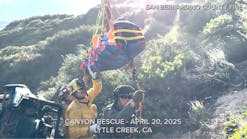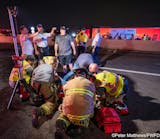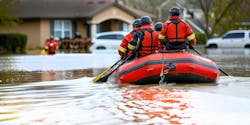If cryogenic liquids are shipped above 41 psi and have no other hazard, they are considered a compressed gas and would be placarded as a non-flammable compressed gas. Cryogenics may carry other placards such as flammable gas, poison gas or oxidizer. If cryogenics do not have any other placardable hazard, they are not considered a hazardous material by the DOT. Materials listed under hazard Class 2 that are shipped as liquefied gases, such as cryogenics, exhibit other hazards not indicated by the placard.
Since they have boiling points of -130 degrees F or colder, all cryogenic liquids are above their boiling points at ambient temperatures. Liquid helium has a boiling point of -452 degrees F below zero; it is the coldest material known. It is also the only material on earth that never exists as a solid, only as a cryogenic liquid and as a gas.
Unlike propane and other liquefied gases, gases that are liquefied into cryogenics are liquefied through a process of alternating pressurization, cooling and ultimate decompression. Therefore, they do not require pressure to keep them in the liquid state. However, if they will be in containers for long periods, they are pressurized to keep them liquefied as long as possible. Non-pressurized cryogenics are kept cold by the temperature of the liquid and the insulation around the tanks.
The cryogenic liquefaction process begins when gases are placed into a large processing container. They are pressurized to 1,500 psi. The process of pressurizing a gas causes an increase in heat. The molecules within a container move faster, causing more collisions with each other and the walls of the container. As the molecules collide, heat is generated. For example, the top of a self-contained breathing apparatus (SCBA) bottle or an oxygen bottle becomes hot as it is being filled. This is a result of the molecules colliding in the bottle. Once the pressure of 1,500 psi is reached, the material is cooled to 32 degrees F by using ice water. Once cooled, the pressure is once again increased, this time up to 2,000 psi, again accompanied by an increase in temperature. The material is then cooled to -40 degrees F with liquid ammonia. Once the material is cooled, all of the pressure is released at once and the resulting heat decrease turns the gases into cryogenic liquids. During the decompression process, the heat present within the container decreases as the pressure rapidly decreases.
Many of the gases found on the Periodic Table of Elements are extracted from the air and turned into cryogenic liquids. These include neon, argon, krypton, xenon, oxygen and nitrogen. All of the gases except oxygen are considered inert; that is, they are non-toxic, non-flammable and non-reactive. To extract these materials from the air, the air is first turned into a cryogenic liquid. Then the liquid air is processed through a type of distillation tower where each component gas is extracted off as it reaches its own boiling point. Once extracted, the gases are then liquefied by the same process of alternate pressurization and decompression.
Other common materials that are made into cryogenics include flammable methane (LNG), hydrogen, oxidizers oxygen, fluorine and nitric oxide.
Helium (chemical symbol He). Helium, a gaseous non-metallic element from family eight on the Periodic Table, is a colorless, odorless and tasteless gas. It is non-flammable, non-toxic and non-reactive. Helium has a boiling point of -452 degrees F. It is slightly soluble in water.
Even though it is an inert gas, helium can still displace oxygen and cause asphyxiation. The vapor density is 0.1785, which is lighter than air. Helium is derived from natural gas by liquefaction of all other components. Helium has a United Nations (UN) four-digit identification number of 1046 as a compressed gas and 1963 as a cryogenic liquid.
Neon (Ne). Neon is a gaseous non-metallic element that is colorless, odorless and tasteless. Neon is present in the earth's atmosphere at 0.0012 percent of normal air. It is non-flammable, non-toxic and non-reactive, and it does not form chemical compounds with any other chemicals. It is, however, an asphyxiant gas and will displace oxygen in the air.
The boiling point of neon is -410 degree F. It is slightly soluble in water. Neon has a vapor density of 0.6964, which is lighter than air. The UN number is 1065 when compressed and 1913 as a cryogenic liquid. Its primary uses are in luminescent electric tubes and photoelectric bulbs. It is also used in high-voltage indicators, lasers (liquid) and cryogenic research.
Argon (Ar). A gaseous non-metallic element of family eight, argon is present in the earth's atmosphere to 0.94 percent by volume. It is a colorless, odorless and tasteless gas that does not combine with any other chemicals to form any compounds.
The boiling point of argon is -302 degrees F. It is slightly soluble in water. The vapor density is 1.38, so it is heavier than air. The UN number is 1006 as a compressed gas and 1951 as a cryogenic liquid. It is used as an inert shield in arc welding electric and specialized light bulbs (neon, fluorescent and sodium vapor), in Geiger-counter tubes and lasers.
Krypton (Kr). Krypton is a gaseous, non-metallic element of family eight. It is present in the earth's atmosphere to 0.000108 percent by volume. It is a colorless, odorless gas that is non-flammable, non-toxic and non-reactive. It is, however, an asphyxiant gas and can displace oxygen in the air. At cryogenic temperatures, krypton exists as a white, crystalline substance with a melting point of 116 degrees K. The boiling point of krypton is -243 degrees F. Krypton is known to combine with fluorine at liquid nitrogen temperature by means of electric discharges or ionizing radiation to make KrF2 or KrF4. These materials decompose at room temperature. Krypton is slightly water soluble. The vapor density is 2.818, which is heavier than air. The UN number is 1056 as a compressed gas and 1970 as a cryogenic liquid. It is used in incandescent bulbs, fluorescent light tubes, lasers and high-speed photography.
Xenon (Xe). Xenon is a gaseous, non-metallic element from family eight. It is a colorless, odorless gas or liquid. It is a gas at standard temperatures and pressures. Xenon is non-flammable and non-toxic but is an asphyxiant and will displace oxygen in the air. The boiling point is -162 degrees F. The vapor density is 05.987, heavier than air. It is chemically unreactive but not completely inert. The UN number is 2036 for the compressed gas and 2591 for the cryogenic liquid. Xenon is used in luminescent tubes, flash lamps in photography, lasers and as an anesthesia.
Xenon compounds. Xenon combines with fluorine through a process of mixing the gases, heating in a nickel vessel to 400 degrees C and cooling. The resulting compound is xenon tetrafluoride, XeF4. The resulting product is composed of large colorless crystals. Compounds of xenon difluoride, XeF2, and hexafluoride, XeF6, can also be formed in a similar manner. The hexafluoride compound melts to a yellow liquid at 122 degrees F and boils at 168 degrees F.
Xenon and fluorine compounds will also combine with oxygen to form oxytetrafluoride, XeOF4, which is a volatile liquid at room temperature. These compounds with fluorine must be protected from moisture to prevent the formation of xenon trioxide, XeO3, a dangerous explosive when dried out. The solution of xenon trioxide is a stable weak acid that is a strong oxidizing agent.
Large Expansion Ratios
Cryogenic liquids have very large expansion ratios, some as much as 900 or more to one; they can form massive vapor clouds. These vapor clouds can obscure vision of the source of the leak making the location of the source difficult to find.
Vapor clouds from cryogenic liquids can travel great distances and require evacuation of the public. The visible cloud is not the total extent of the hazard. The warmer air on the outer edge of the vapor cloud causes the gas to become invisible. It is then possible to be in an oxygen-enriched atmosphere, flammable atmosphere or in a gas that can cause asphyxiation and the gases will not be visible.
Because of the large liquid-to-gas expansion ratios, the other hazards of cryogenic liquids are magnified many times. If the cryogenic liquid is flammable or toxic, these hazards are intensified because of the potential of large gas cloud production from a small amount of liquid. As the size of the leak increases, so does the size of the vapor cloud. This means that one gallon of a cryogenic liquid can produce as much as 900 gallons of a gas.
Cryogenic liquids can turn into gases and displace oxygen in the air, which can harm responders by simple asphyxiation not having enough oxygen to breathe. The atmosphere contains about 21 percent oxygen. When the oxygen in the lungs (and ultimately in the blood) is reduced, unoxygenated blood reaches the brain and the brain shuts down. It may only be a few seconds between the first breath and collapse. Response personnel should always don SCBA before entering a confined space or other area where asphyxiant gases may be present.
Being very cold, cryogenic liquids can cause frostbite and solidification of body parts. When the parts thaw out, the tissue is irreparably damaged. Touching uninsulated piping and valves of cryogenic liquid containers can cause skin to stick to the metal, much like when a child's tongue is put on an ice cube tray or fence post and it becomes stuck.
There is no clothing or equipment that can be worn to protect the body from the effects of contact with a cryogenic liquid. Anything the cryogenic liquid contacts will become solidified and brittle. Gloves can prevent skin from contacting piping and valves. Body parts that have come in contact with cryogenics should be treated like frostbite. They should be flushed with water that is cool to lukewarm to limit additional tissue damage.
Cryogenic liquids are shipped and stored in special containers. On the highway the MC 338 tanker is used to transport cryogenic liquids. The tank is usually not pressurized but is heavily insulated to keep the materials cold. A heat exchanger underneath the belly of the tank truck facilitates the off-loading of product as a gas. Railroad cars are also specially designed to keep the cryogenic liquids cold inside the containers to minimize the boiling off of the gas.
Fixed storage containers of cryogenic liquids are usually tall, small-diameter tanks. These are insulated and resemble large vacuum bottles that keep the liquid cold. These containers are also under pressure to keep the material liquefied. There is a heat exchanger near the tanks. This heat exchanger is a series of metal tubes with fins around the outside. The liquids are passed through the tubes and the liquid is warmed above its boiling point and turns into a gas. The gas is then used in the facility for whatever purpose it was intended.
Valves on fixed tanks have long stems because the moisture around the valves is frozen due to the cold of the cryogenics. As this moisture is frozen, ice forms on the piping and around the valves. If the valve stem were not long, the valve would not be accessible because of the ice. Portable containers used for cryogenic liquids, called Dewar flasks, have an inner tank surrounded by insulation with an outer shell. The tanks have a liquid level gauge and off loading valves on the top. There is also a rupture disk in the event the container becomes overpressurized.
Other gases, such as hydrogen, are liquefied, sometimes made into cryogenics and placarded as flammable gases. Liquid oxygen is placarded as an oxidizer or non-flammable compressed gas. Oxygen, though non-toxic, is very reactive with hydrocarbon based materials and is an oxidizer. Liquid oxygen in contact with an asphalt surface such as a parking lot or highway can create a contact explosive. Dropping an object, driving over the area or even walking on the area can cause an explosion to occur.
Nitrogen (N). Nitrogen is a gaseous, non-metallic element that is the second-most-produced industrial chemical (more than 68.04 billion pounds in 1995). It is a colorless, odorless and tasteless gas that makes up 78 percent of the air that is breathed. The boiling point of nitrogen is -320 degrees F. It is slightly soluble in water.
Nitrogen does not burn and is non-toxic. It may, however, displace oxygen and be an asphyxiant gas. The vapor density of nitrogen is 0.96737, which makes it slightly lighter than air. The UN number is 1066 as a compressed gas and 1977 as a cryogenic liquid. As a cryogenic liquid, the National Fire Protection Association (NFPA) 704 designation is Health-3, Flammability-0 and Reactivity-0. Nitrogen is used in the production of ammonia, cyanides and explosives, as an inert purging agent and as a component in fertilizers. It is usually shipped in insulated containers, insulated MC 338 tank trucks and railroad tank cars.
Oxygen (O). Like nitrogen, oxygen is an non-metallic elemental gas, which is the third-largest-volume industrial chemical with 53.48 billion pounds produced in 1995. Its boiling point is -297 degrees F. It is non-flammable but supports combustion. Oxygen can explode when exposed to heat or organic materials. The vapor density of oxygen is 1.105 which makes it slightly heavier than air.
Oxygen is incompatible with: oils, grease, hydrogen, flammable liquids, solids and gases. The UN number is 1072 as a compressed gas and 1073 as a cryogenic liquid. The NFPA 704 designation for liquid oxygen is Health-3, Flammability-0 and Reactivity-0. Liquid oxygen is shipped in Dewar flasks, MC 338 tank trucks and cryogenic rail cars.
Carbon dioxide (CO2). The 22nd-highest-volume industrial chemical (10.89 billion pounds produced in 1995), carbon dioxide is a colorless and odorless gas. It can also be a solid (dry ice), which will undergo sublimation and turn back into carbon dioxide gas, or a cryogenic liquid. CO2 is miscible with water and is not flammable or toxic but can be an asphyxiant gas and displace oxygen.
In 1993, two workers aboard a cargo ship were killed when a carbon dioxide fire extinguishing system discharged. The oxygen in the area was displaced by the carbon dioxide and the men were asphyxiated.
Carbon dioxide has a vapor density of 1.53, which is heavier than air. It may be shipped as a cryogenic or liquefied compressed gas. It has a UN number of 2187 as a cryogenic and 1013 as a compressed gas. The NFPA 704 designation is Health-3, Flammability-0 and Reactivity-0. It is used primarily in carbonated beverages and fire extinguishing systems.
When responding to fires involving liquefied gas tanks, firefighters often apply water to cool the tanks. Cryogenic liquids are already colder than water at any temperature and water will act as a superheated material, causing the cryogenic to heat up and vaporize faster. This will cause pressure to build up inside the tank and the tank may fail violently. Care should be taken when applying water to "cool" cryogenic containers.
Robert Burke, a Firehouse® contributing editor, is a Maryland-based certified Hazardous Materials Specialist and has served on state and county hazmat response teams. He has 16 years' experience in career and volunteer fire departments, attaining the rank of assistant chief, and has served as a deputy state fire marshal. He holds an associate's degree in fire protection technology and a bachelor's degree in fire science. Burke is an adjunct instructor at the National Fire Academy and the Delaware County, PA, Fire Academy.






